
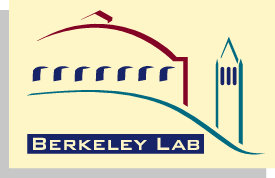

By Allan Chen
Berkeley Lab has won three of the six Federal Energy Management Awards given to national laboratories for 1996 accomplishments in saving energy. The Federal Interagency Energy Policy Committee and the Department of Energy present these awards to recognize outstanding contributions that increase energy efficiency in the federal sector.
The Lab's three awards are for HVAC energy efficiency retrofits (heating, ventilation, air conditioning); lighting efficiency retrofits; and measurement and verification (M&V) guidelines developed for the Federal Energy Management Program (FEMP). The awards help draw attention to the federal government's efforts to reduce its energy use by 30 percent in 2005. Berkeley Lab has already exceeded this goal in its own facilities.
HVAC retrofit
The HVAC team completed six energy efficiency retrofit projects in 1996 to make heating, ventilating, air conditioning, process equipment cooling and lighting retrofits in 28 buildings more efficient. The Lab's In-House Energy Management (IHEM) Program estimates the total annual cost savings from these projects at $318,000 or 24 percent of the pre-retrofit annual energy cost of the equipment. Over the lifetime of these projects, air pollution and greenhouse gas emissions (sulfur dioxide, nitrogen oxides and carbon dioxide) will be reduced by an estimated 193,256 tons.
"The team used several innovative technologies in the project," said Doug Lockhart, head of IHEM. "One was a variable air volume system with carbon dioxide sensors in Bldg. 90. Sensing an increase in CO2 when building occupancy is high, the system can automatically increase ventilation." In Bldg. 64, high efficiency modular boilers can better match hot water needs than the old boiler; modules of the boiler shut down as demand drops. The project team consisted of Lockhart, Geoffrey Bell, Steve Greenberg, Dennis Kincy, Rachel McGee, Charles Taberski, and Bela Torkos, all with the Facilities Group.
Lighting upgrade
The sitewide lighting upgrade retrofit project made lighting systems in more than 40 Lab buildings more efficient. The retrofits included replacing T-12 fluorescent lamps and magnetic ballasts with more efficient T-8 lamps and electronic ballasts; incandescent lamps with compact fluorescent lamps; and incandescent exit signs with LED exit signs. In addition, occupancy sensors were installed to turn off lights in unoccupied areas. The total annual cost savings from this work was about $126,000, or 35 percent of the pre-retrofit annual energy cost of the equipment.
Over the lifetime of this project, air pollution will be reduced an estimated 124,000 tons.
"Berkeley Lab was one of the first large sites in the United States to commit to the T-8 lamp and electronic ballast technology when this project began, which has since become the standard in commercial retrofits," says Lockhart. Lab staff participating in this project were Marshall Hilburn, Mack Morgan, Charles Taberski, Tai Voong and Matthew Wilson.
FEMP guidelines
The third award recognizes an effort to facilitate the process of making all federal facilities more energy-efficient. Berkeley Lab's Steve Kromer, along with Doug Dahle of the National Renewable Energy Laboratory and Steve Schiller of Schiller Associates developed Measurement and Verification Guidelines, published in 1996, for the Federal Energy Management Program.
The M&V Guidelines have become a national standard for determining energy savings from performance contracts. By providing standard procedures to quantify the savings resulting from the installation of energy conservation measures, they provide a common language for parties involved in the contract, which minimizes the risks to both parties. The protocols defined in the guidelines have been used not only by federal agencies, but by energy efficiency programs sponsored by utility companies across the nation, and by contractors in the private sector.
"We are proud to represent the Lab in the receipt of these awards, and to be recognized for our efforts to minimize the cost of doing business while improving the environment," Lockhart says. "We give our thanks to the support, management, and programmatic staff who made these accomplishments possible. My congratulations to the award winners and many thanks for a job well done."

By Reid Edwards, Manager, Government Relations
August is a traditional month for family vacations and thoughts of returning to school. It is also the traditional hiatus in the Congressional budget process, and, therefore, a good time to assess the progress and outlook for the Laboratory's budget in the new fiscal year, which begins Oct. 1.
The majority of the Laboratory's federal funding is contained in two separate appropriations bills. The Interior appropriations bill funds DOE's energy efficiency and fossil energy programs, while the energy and water appropriations bill funds all of DOE's Office of Energy Research, renewables, defense, and all other DOE programs. Each bill moves on a separate track, through a similar process, and is hopefully signed into law before the beginning of the fiscal year.
The energy and water bill has passed both the House and Senate, and differences in the two versions (as described below) will be ironed out in a House-Senate conference in early September. Expectations are that this bill will be signed into law in September.
The Interior bill is another matter. It has passed the House, but not the Senate, so it is further behind in the process. Furthermore, the bill contains many controversial items, such as cuts in support for the National Endowment for the Arts and reductions in programs for Native Americans and national parks, that jeopardize its passage. This bill may not be completed before Oct. 1, and a continuing resolution to temporarily fund these programs at some undetermined level may be necessary until the negotiations are concluded.
Overall, funding for programs important to Berkeley Lab fare well in these bills. The high energy physics program has a small increase in the Administration request, which was supported by the Senate, and an additional $5 million was added by the House. The nuclear physics budget request was equal to last year's total but, again, the House added $5 million. Both the House and Senate supported the requested increase of almost $19 million for the basic energy sciences program. The biological and environmental research programs face a budget reduction in the House and Senate bills consistent with the Administration request, but the cut is largely due to the completion of a major construction project.
The fusion program is funded in the House at the requested level of $225 million, a reduction of $7.3 million below last year's level, while the Senate boosted the budget to $240 million. Neither the House nor the Senate provided funding for DOE's involvement in the Administration's proposed Next Generation Internet program. The Senate, unlike the House, provided $10 million to renew the Office of Energy Research's science education programs.
In the Interior appropriations bill, both the House and Senate provided increased funds for energy conservation over the current fiscal year, but both totals were below the Administration request. The FY 1997 budget for these programs is $570 million. The Administration request for next year is $708 million; the House provided $645 million and the Senate $627 million. Most of the laboratory's energy efficiency funding comes from the building technology program, and there the House reduced the funding $6 million below the current year, while the Senate provided a $20 million increase over this year's budget.
Overall, the Congressional budget process looks promising for the Laboratory's fiscal year 1998 budget. The recent agreement to reach a balanced budget by 2002, at the latest, does not appear to require major reductions in federal R&D in the coming years, as had been previously feared. While budgets will continue to be tight and major new initiatives difficult to start, like the beginning of a new school year, we can look to the coming year with a sense of overall optimism.

By Paul Preuss
A new report bearing the jawbreaking title "Market Research, Customer Satisfaction Measurement, and Marketing Government-Funded R&D Laboratories to Industry" was presented recently at the annual conference of the Tech Transfer Society in Denver, Colo. The report was coauthored by Bruce Davies of the Lab's Technology Transfer Department and Judy Marcure, a visiting market researcher from the Commonwealth Scientific and Industrial Research Organization (CSIRO), Australia's national scientific R&D organization.
The report summarizes the experiences of 154 companies who are now doing cooperative research at Berkeley Lab or who have done so in the past three years.
"A majority of the people who filled out the questionnaire were chief executives or R&D managers," says Davies. "Their responses provide unusual insight into what industry expects from Berkeley Lab and how well we are meeting those expectations."
The industries significantly represented among the companies who sent back the survey were biotechnology, energy, environment, medicine, chemicals, advanced materials, and pharmaceuticals. They worked most often with Berkeley Lab's divisions of Materials Sciences, Energy and Environment, Life Sciences, and Engineering, although all divisions were represented.
Respondents were asked to rate the Lab's most important functions and attributes, and how well these were performed. One gratifying result was that core capabilities, such as the quality of the lab's basic and applied science, staff accessibility, and unique scientific facilities and resources, were ranked high in both importance and performance.
The study also showed that there is room for improvement, even though the "breakthrough potential" of discoveries made in cooperation with Berkeley Lab researchers compensated for some disappointments. Companies rated "intellectual property protection" higher in importance than any other single attribute or function, but gave the Lab a barely adequate performance score.
"The LBNL researcher is the single most significant source of contact with the industry," the authors note. To help researchers be more effective in dealing with industry, the Technology Transfer Department will seek to educate lab scientists and engineers about industry concerns such as intellectual property protection. Plans for workshops and a quarterly intellectual-property newsletter are in the works.
Performance on contract negotiation, a moderately important value, rated lowest of all in performance, but as Davies and Marcure suggest in their report, "we must take into account responses to open questions that suggested some government regulations could be considered a disincentive by some industry partners."
How do companies hear about opportunities for working with Berkeley Lab researchers? Scientific conferences, technical seminars, and scientific publications were the most important sources of information. Surprisingly, "internally managed marketing research," over which the Lab has no direct control, was cited by more than a fourth of respondents--a response reflected in the fact that half the companies took the first step in contacting the Lab, citing its excellent scientific reputation.
Marketing R&D services is not easy, says the report, because "marketing aims to give the marketplace what it desires. . . . It offers little help in the search for partners to support the conduct of pre-competitive research for which no known market demand exists."
Says Davies, "Finding new ways for the Lab to work with industry is a challenge that will be met partly by drawing upon the experience of established research organizations like Australia's CSIRO, and partly by studies like this one that ask blunt questions of the companies we hope to serve."


Bill McCurdy, associate laboratory director for computing sciences, will discuss the future of scientific computing in a presentation entitled "Limitations of Silicon and Software: The Implications for Our Future," starting at 11:30 a.m. Thursday, Aug. 28. All employees are invited to attend the talk in the Bldg. 50 auditorium.
"The nation's race into the age of high-performance computing over the past 20 years has produced an uneven collection of spectacular successes and failures in scientific computing, both in hardware and in software applications," McCurdy says. So far, he says, the underlying rule of the race has been Moore's Law, which states that the power of computers increases by a factor of two roughly every 18 months. Businesses, financial investors and pre-teenage users of computer games have all come to rely on the exponential growth of computing power as the foundation of their current acquisition strategies. Scientists have based critical aspects of their research strategies on the same growth curve.
"No other phenomenon in society or physics has displayed exponential growth without limit," he says. "We are likely to learn within the next decade that computing is no different. The computing hardware race will "hit the wall" and the taken-for-granted exponential increases in speed and power will slow dramatically and a different evolution will begin."
McCurdy's presentation is intended to open the debate about the future of computational science at Berkeley Lab. He will explore the technical and financial origins of Moore's Law as well as its limits. He will also discuss the impact of powerful desktop computing on scientific research and the scientific community's response to this modern phenomenon.
"The turmoil in the computing industry may galvanize a shift in our thinking from focusing on hardware to beginning a sea change in scientific research that requires a new kind of investment altogether," he says.

Photo: The DOE Oakland Operations Office and Berkeley Lab hosted the semi-annual DOE/ Laboratory Site Managers Meeting at the Lab Aug. 5-7. The site managers are located at DOE laboratories around the country to provide for the execution of DOE programs and to oversee environment, safety and health, and facility operations. During the three-day meeting, the group conducted workshops on integrated safety management and performance assessment programs, and discussed transition planning at Brookhaven National Laboratory. They also discussed DOE field/headquarters office roles and alignment. (XBD9708-03148) Photo by Roy Kaltschmidt

Judith Campisi, head of the Department of Cell & Molecular Biology in the Life Sciences Division, has been named the recipient of the 1997 AlliedSignal Award for Research on Aging. The award was bestowed on Campisi by the Alliance for Aging Research and the AlliedSignal Corp. for her pioneering work on the role of cellular senescence in organismic aging. Ultimately, the goal of her research is to improve the quality of life of older Americans by reducing the incidence of age-related diseases and disabilities.
The first installment of the $200,000 grant will be presented to Campisi at an Oct. 28 awards dinner in Washington D.C.
The Alliance for Aging Research is the nation's leading citizen advocacy organization for promoting scientific research in human aging and working to ensure healthy longevity for all Ameri-cans. AlliedSignal is an advanced technology and manufacturing company.
Photo: Judith Campisi (XBD9708-03253)

During his 20-year career at the Lab, Turner was involved primarily with materials specifications. Drawing on his engineering expertise, he wrote a book entitled "Plastics in Nuclear Engineering."
Richard (Dick) Burly, the Lab's chief engineer at the time, said Turner was his primary advisor on materials, both plastic and metal.
"Jim was a true gentleman and a good friend," said Burly. "He was also a great photographer at the Lab's big parties."
Turner is survived by his wife Elizabeth, sons Tom and Henry, and grandchildren Bret, Katy, India, and Meg.


By Jon Bashor
The National Energy Research Scientific Computing Center (NERSC) this month achieved a milestone in high-performance computing: successfully stopping and restarting a number of scientific computing jobs on a CRAY T3E supercomputer without any data processing loss or discontinuity.
Called "checkpointing," the stop/restart procedure--achieved twice in one week at NERSC--is believed to be the first time such a procedure has been accomplished on a massively parallel processor (MPP) supercomputer. Checkpointing has been a major goal in the MPP community for the 10 years since the first parallel machine was plugged in. C. William McCurdy, head of the Lab's Computing Sciences, called the procedure "a remarkable achievement."
Checkpointing involves bringing all of the programs running on the computer to the same stage and stopping them, then recording all the information, transferring that information out of the machine to allow work on the system, then putting it back in and getting it all running again--on a machine capable of carrying out tens of billions of operations per second. A simple analogy would be to give 1,000 kindergartners each 10 crayons (which they are encouraged to share) and a picture to color in 10 stages. The teacher would then get them all to stop at the same time at the fourth stage, collect all the pictures and crayons, put them away on a shelf and then return all the materials to their original student the next day.
"As far as I know, no other MPP system is planning to do system-wide checkpoint/restart without having to reprogram applications," said Bill Kramer, deputy director of NERSC. "Therefore, this is really a momentous step for those of us in the high-performance computing community."
Successfully checkpointing will allow the NERSC staff to use the 512 processors of its CRAY T3E more efficiently by moving jobs between the processors and making larger pools of processors available quickly for bigger jobs. It will also allow NERSC to make the entire 512-processor computer available to tackle a single, complex problem when necessary, as well as carry out upgrades and maintenance without disrupting the work of hundreds of researchers from around the country.
"This signifies a major milestone in Cray's and NERSC's commitment to provide robust, reliable Massively Parallel Processor computing cycles to DOE's unclassified energy research community," said Michael Declerck of the NERSC Systems Group. Declerk is the computer scientist charged with putting the T3E-900, which was delivered in mid-July, through its month-long acceptance tests.
The successful checkpointing was the result of software developed by Cray Research Inc. and close collaboration between NERSC and Cray to refine the application. The procedure was successfully demonstrated on both of NERSC's CRAY T3E supercomputers, the 512-processor T3E-900 and the 160-processor T3E-600. The checkpointing was performed once to allow scheduled maintenance and a second time to test advanced operating system features. The restarted jobs were running on clusters ranging from 16 to 256 processors.
"After we completed the downtimes, all of the user jobs on the machine were successfully restarted and the machines were put back on line," said James Craw, head of the NERSC Systems Group. "It's kind of ironic that we achieved this major milestone and none of our users noticed--which was our objective."

Photo:Employees test drive ergonomic office chairs and accessories during a three-day Ergonomics Fair held last month in Perseverance Hall. To learn more about the Lab's ergonomics program, visit the web at http://www-ehs.lbl.gov/ergo/index.htm, or call Larry McLouth at X5286. The Ergonomics Display Center, located in Bldg. 26-126, is open Monday through Friday, 11 a.m. to 3 p.m. No appointment is necessary. (XBD9708-03109)
Photo by Joe Moore

Waste Management Participates in Brown Bag Forum
At a lunchtime forum on community issues held in Perseverance Hall on Aug. 1, EH&S Division Director David McGraw and others spoke to Lab employees about issues of concern to citizens living in communities near the Laboratory. Waste Management (WM) group leader Robin Wendt discussed the new waste handling facility (Bldg. 85) and answered several questions about the facility and about the Lab's waste practices. He also pointed out that WM routinely gives tours and responds to concerns of the public, city governments, and the press. This is part of a continuing effort to better inform these groups of the careful waste practices at the new waste handling facility and its state-of-the-art fire protection, seismic, and emission control technology. If you have questions, would like to tour the facility, or just want to better understand issues of concern, contact Wendt at X6012.
Survey on Use of Products with Recycled Content
Do you use products with recycled content? This and other questions were raised in a recent Recycled Products Questionnaire sent out by the Berkeley Lab Waste Minimization Team. Procurement records how many products the Lab is procuring with recycled content. The survey helped the department understand the reasons people elect to buy or not buy products with recycled content. It also heightened awareness and identified some misconceptions.
The following is a summary of the results, which readers might find interesting:

For more information, contact recycling coordinator Shelley Worsham at X6123. To review Executive Order 12873, access http://es.inel.gov/program/ exec/eo12873.html


The 20th annual Berkeley Lab Runaround will take place at noon on Friday, Oct. 10. The 3.0 kilometer fun run will start promptly at noon near the Firehouse (Bldg. 48) and end at the cafeteria parking lot. All employees and retirees are encouraged to participate; there will be ample time for everyone, whether running, walking, or strolling, to complete the course.
All participants will receive 20th anniversary Runaround T-shirts, designed this year by TEID's Marilee Bailey. Individual and group costumes are welcome, and repeat runners are encouraged to wear their oldest Runaround T-shirt.
Following the event, there will be food, music, and fun prizes, and trophies will be awarded to the first man and first woman to finish the course. The top three men and women in each age category will receive medals.
Watch future issues of Currents for more information and course map.

A free, day-long seminar on maintaining the security of UNIX-based computer systems when connecting to the Internet will be held from 8:30 a.m. to 5 p.m. on Wednesday, Sept. 10, in the Bldg. 50 auditorium. The seminar is designed for security, systems, and network specialists responsible for managing and ensuring the availability and integrity of an organization's information systems.
The session will be taught by Secure Systems Services, drawing on resources provided by DOE's Computer Incident Advisory Capability (CIAC) team. The seminar will cover current Internet threats, general trends, case studies, security measures, viruses and more.
Although there is no charge, participants must register in advance. For more information or to register, contact Ewa Elkins at X7477 or EAElkins@lbl.gov.
For information about course content, contact Sandy Sparks at 422-8193 or send email to ciac@llnl.gov. A seminar web site has been set up at http://www.lbl.gov/ICSD/Security/ seminar.html

A new signature with the words "Berkeley Lab" has replaced the Chief Financial Officer's signature on checks issued both by the Accounts Payable System and the Travel Disbursement System. It will also soon appear on all automated payroll checks.
The change to a "Berkeley Lab" signature was recommended by the UC Office of the Treasurer to the Regents. All checks issued with the new signature are negotiable instruments that should be honored by financial institutions in the same manner as were checks previously issued with the CFO's signature.
The US Office of the President's administrative procedures for "Reporting Improper Governmental Activities and Protection Against Retaliation for Reporting Improper Activities" (UC Whistle Blower Policy) are now available online on the UC Human Resources home page ((http://www.ucop.edu/humres/policies/ucop/whistle.html)).
The procedures were revised in May 1997 to identify the assistant vicepresident for human resources as the retaliation complaint officer and the director of personnel services, or his/her designee, as the administrator of the retaliation complaint procedures.
If you have questions regarding these procedures, contact David Turner, employee and labor relations coordinator, at 987-0828 or David.Turner@ucop.edu.

Seaborgium pins--made in honor of the naming of seaborgium, element 106, after Berkeley Lab Associate Director-at-Large and Nobel Laureate Glenn Seaborg, are now available for purchase through the Employee Buying Service. The small blue pins, with the ensignia Sg, are $5 each.

Heather Pinto of the EH&S Division and her husband Manuel are the proud parents of a son, Sergio Francisco Pinto, born Sunday, June 22. The baby weighed 8 lbs 11.5 oz and was 21.5 inches at birth. He is the couple's first child.

Oracle Channel Classes
The following Oracle Channel courses will be held from 8:45 a.m. to 1 p.m. in Bldg. 936-12. The registration deadline for each class is the Monday prior to the week the class is to be held.
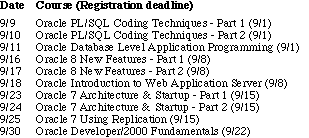
To register for a class, contact Lynellen Watson (fax: X5870, phone: X5999). Course participants are advised to arrive to class on time. For information about class content, visit the web at http://www.lbl.gov/Workplace/EDT/computers/oracle.html
Computer Courses
The following on-site computer courses for windows are taught from 9 a.m. to 4 p.m. in the Bldg. 51L computer room. The cost is $100 for each of these one-day courses (except for Windows 95 Transition and Windows 95 Fundamentals, which are free).
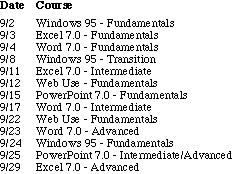
The following are free three-hour courses covering the basics of cc:Mail and Meeting Maker:

To enroll, complete an AIM Enrollment Form (located on Employee Development and Training's website (http://www.lbl.gov/Workplace/EDT/computers/PC_Classes.html), obtain your supervisor's approval, and fax it to AIM at 827-1614. You will receive a confirmation call within two business days. Cancellation policy: Your division account will be charged for on-site computer classes that have a fee unless you cancel five working days prior to the class you are scheduled to attend.
EH&S Courses
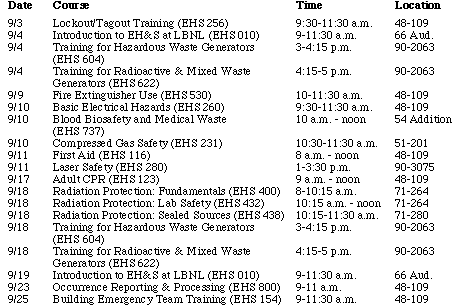
*Pre-registration is required for all courses except Introduction to EH&S. To pre-register for all other classes, send e-mail to training-registration@lbl.gov or a fax to X5870 with your name, employee ID number, extension, and class name, date & EH&S class code (or call X5999).


The Berkeley Lab Calendar is published biweekly here on the World Wide Web and in Currents by the Public Information Department. Employees can list a meeting, class, or event in the Calendar by using this submission form. The deadline for submissions is 5 p.m. on Monday in the week that Currents is published.In addition to the events listed below, Berkeley Lab's Washington, D.C. Projects office is hosting a Science and Technology Seminars series.
Scientific Conferences

7:30 a.m. - 4:30 p.m., Bldg. 54 parking lot.
Today is the last day to purchase discount tickets for Berkeley Lab's Family Day trip to see the Oakland A's play on Sept. 20.
"Status of the OK-4/Duke Storage Ring XUV FEL and Monochromatic Gamma Ray Source" will be presented by Vladimir Litvinenko of Duke University at 11 a.m. in Bldg. 2-100B.
ALS/CXRO Seminar
"Electron Decay Spectra of Core-Excited Molecules Under Resonant Raman Conditions" will be presented by Maria Novella Piancastelli of the University of Rome at 3:30 p.m. in Bldg. 2-100B.
"A Fifth-Generation Storage Ring-Based Coherent Light Source" will be presented by Vladimir Litvinenko of Duke University at 11 a.m. in Bldg. 4-102B.
Joint Nuclear Science & Physics Division Research Progress Meeting
Fumihiko Seukane of Tokyo University will speak at 4 p.m. in Bldg. 70A-3377, title to be announced; refreshments, 3:40 p.m.
"Energy Star Home Ventilation" will be presented by Judy Roberson and Nance Matson of EETD at noon in Bldg. 90-3148.
Surface Science and Catalysts Science Seminar
"Selective Oxidation of Alcohols and Ployols on Platinum-Group Metals" will be presented by Pierre Gallezot of the Institut de Recherche sur la Catalyse, Villeurbanne, France, at 1:30 p.m. in the Bldg. 66 auditorium.
Physics Division Research Progress Meeting
"Recent Results from DELPHI" will be presented by Louis Lyons of Oxford University at 4 p.m. in Bldg. 50A-5132; refreshments, 3:40 p.m.
"The Micromanipulation of Model Biomembranes on Solid Supports" will be presented by Paul Cremer of Stanford University at 1:30 p.m. in the Bldg. 66 auditorium.

Winners of the 1997 softball season were determined in playoff games held Wednesday, Aug. 13, at Kleeberger Field. Winners of the first round played for first and second place, the two remaining teams played for third and fourth place. Scores and final standings are listed below.
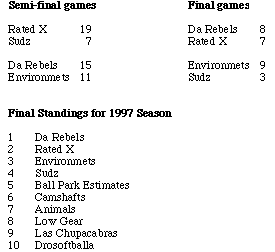
Photo:Da Rebels, the winning team of Berkeley Lab's 1997 softball season, includes team members (from left) Rudy Bartolo, Will Hubert, Randy Yow, Tammy Yow, Cory Lee, Norma Burke, Richard Montez (kneeling in front), Eric Munson, Michelle Garcia, Derrick Benjamin, Sue Tavares, Bryan Holmes and Larry Mills. Team members not in the photo include Eric Clausen, Manuel Gonzalez and Anytra Henderson. (XBD9708-03207)Photo by Mary Padilla

The 1997 season of the Berkeley Lab Bowling League gets under way on Wednesday, Sept. 3, at Albany Bowl, 540 San Pablo Ave. A 5:30 p.m. meeting will be followed by bowling at 6 p.m. For more information or to sign up, call Harold Blair at X7685.

"Take Me Out to the Ball Game!"
Spend a day of fun with the Lab's Employee Activities Association on Saturday, Sept. 20, for Berkeley Lab Family Day at the Oakland Coliseum. For only $4 per person (regular price $13), you will have field level seating to watch the Oakland A's play the Seattle Mariners. You will also receive a $2.50 food coupon for each ticket purchased.
Tickets must be ordered and paid for by Thursday, Sept. 4, at the Employee Buying Service (EBS) table in the Lab cafeteria. Tickets will be available for pick-up in the cafeteria the week of Sept. 15-19. Sales are limited; first come, first served. For more information, see Helen Coleman at the EBS table.

'84 NISSAN Stanza, 4-dr sedan,
5-spd, loaded, 120K, new tires, brakes & battery, newly registered, $1400/b.o. Chen, X5315, 883-0368
'87 CHEVETTE, 4-dr hatchbk, a/t, a/c, 34K mi., exc. cond. $2995/b.o. X7729, 799-7041
'87 CHEVY Nova, 4-dr sedan, 95K mi., a/t, AM/FM radio, runs great, gd commute car, leaving country, must sell, $1700. Yasuji, X6645
'87 PORSCHE 944, red, a/c, 195K mi., 1 owner, exc. cond. in/out, runs great, $9K/b.o. 549-1345
'96 CHEVY Cavalier, 4-dr, blue, 19K mi., immac. cond., under 3 yr./36K mi. full warranty, a/t, a/c, stereo/cass., $10,800. 741-7732
CAMPER SHELL, brn/tan, fiberglass, for Toyota short-bed pickup, $200; stock black matte bumper for Toyota short-bed 4WD pickup, will probably fit 2WD, $50. Rich, X6015
CAMPER VAN, pop-top, '93 Ford E250, self-contained, slps 4, a/c, AM/FM cass., exc. cond., $23K. Don, 233-5846
MOTORCYCLE, '95 Ducati 900SS-SP (Special Production), full fairing, mint, stock, 1K mi., $9K. 845-9223
S.F. OPERA, Pelleas et Melisande, Sat. 11/29, 8 p.m. & possibly other Sat. eve., Series J operas, balcony ctr, row B, $94/pr. 526-3519
FLUTE for grade school student, willing to pay a reasonable price. Al, X5908, 672-2716
GOLF CLUBS, children's. Olivia, X5792, 233-1088 (eve.)
GOLF CLUBS, ladies, steel, woods & putter. Anne, 685-0725
HIGH CHAIR, wooden, gd. cond. Shelley, X6123, 820-3172
STEP for step exercising. Martha, X4303
CELLO, full sz., made in W. Germany, 2 yr. old, beautiful sound, $2.5K. Nanyang, X5814, 528-8861 (eve.)
COPY HOLDER, electrified, foot pedal controls up/down feed, magnifier lens enlarges several lines, 18" florescent tube, originally $175, $55. Matt, X6347
COUCH, 8-ft. long, camel color w/subtle multi-hues, heavy-duty casters, $175; stuffed chair, moss grn, $45. Bill, X7735, 932-8252
COUCH, lg., gray, sits 3, new cond., $50; treadmill w/computer, $50; digital answering machine, $15; queen-sz. headboard w/shelf, modern design, gd cond., $15. Steve, X7256
FILE CABINET, sturdy, 2-drwr, $90 new, $40; "hanging" baskets drawer system, Elfa/Rubbermaid, 4-7 runner frames; 1-4 runner frame; 10-2 runner wire baskets; 12-1 runner wire & solid baskets all for $220 ($450 new). Mary, X5270, 938-9891
FUTON, 12-layer, dbl, w/6-drwr pine platform, $150. Carol, X4848
GARDEN WINDOW, single pane, bronze, 36"x48"x16", $40. Lou, X5352, 254-1867
HORSE, Strawberry Daiquiri, 11 yr.-old, 16-hand registered Quarter Horse mare, attractive red roan showing 3' to 3'3 in hunters, equitation & jumpers, gd jumping form, well suited for equitation, easy to work with, great teacher for child & sm. adult, $10K/make offer, (owner to college). Genevieve, X4373, 841-9926 (eve.)
OFFICE DESK, wooden, gd sz. w/5 drwrs, very gd cond., $50. Rob or Soong, X5798, 524-3182 (eve.)
ROLLTOP DESK, 5 drwrs, exc. cond., $100; silk ficus tree, 7 ft., $25. Nancy, X4644
SHOWER/BATHTUB ENCLOSURE, cultured granite wall material, off-white w/light blue specks, 1 panel, 60.25"Wx60.75"H, 2 panels 34"Wx60.75"H, w/lg. soap-shampoo shelf, $200. Bruce, X5255, 886-0997
SNOWBOARD, SIMS 152, gd cond., $230/b.o. Ana-Sophia, 685-0725
SNOWBOARD, Burton Air 155, gd cond., grt for beginners & intermediate riders; snowboard boots, Burton Freestyle, sz. 12, gd cond., can be bought sep. or together at low price. Greg, 526-7447
TABLE DESK, cherry, Queen Ann style, $100; ladies golf club set, $50; butcher block microwave stand, $75; table lamps (2), $20 ea.; REI 4-person dome tent, $20; skis, Rossignol 190cm w/Tyrolia 290 bindings, $125; Rossignol poles, $15; Lange woman's boots, sz. 7-1/2, $35. Auben, X4796, 245-0343
VACUUM CLEANER, Regina Housekeeper, upright, missing some tools, $25. Steve, X4304
BERKELEY, Elmwood area, furn. 1-bdrm + flat, sunny, walk to UCB, split level, hill view from lg. terrace, linen, dishes, HiFi, TV, VCR, microwave, garage, avail. for 1 yr. +, prefer 1 resp., mature, neat & nonsmoking visiting scholar, $825/mo. 843-6325
OAKLAND, Rockridge, roommate wanted, female, non-smoker, share 2-bdrm apt in condo. w/pool, spa, sauna & gym, 15-20 min. by bike or bus from LBNL/UCB, nr shopping ctr, BART & bus, $425/mo. 655-6855
WANTED: LBNL Post Doc seeking 1-bdrm apt./house or shared house in Berkeley for 3 mo. (9/24 to 12/24). Aline, X7140
WANTED: sublet housing or apts in nearby area for 2 French students between 8/21-9/9. X4549, Lionel_ Franceschini@macmail.lbl.gov"
WANTED: furn. 2-3 bdrm house/apt for couple of visiting scientists spending sabbatical year ('98) in Berkeley, they have a 15-yr.-old daughter, prefer Berkeley/Albany/El Cerrito area, starting Jan. '98. John, X6318
WANTED: 3 bdrm house/apt in Berkeley or nearby areas for scientist w/wife & 3 children (3, 6 & 8), coming from France 8/12, would like to rent for 1-2 yr., max. rent $1500/mo. Philippe, X7030
SONOMA COAST, 2.16 acres, Timbercove, Ft. Ross area, all utils. Nick, 527-1965
LOST: aluminum bat, "Black Max", silver & purple, 28 oz., 34" length, Wed., 8/13 at Kleeberger Field. Tony, X5087, X7881




EDITOR: Mary Bodvarsson, X4014, mgbodvarsson@lbl.gov
STAFF WRITERS: Jeffery Kahn, X4019; Paul Preuss, 6249; Lynn Yarris, X5375
CONTRIBUTING WRITERS: Jon Bashor, 5849; Allan Chen, X6249; Monica Friedlander, X5122
PRODUCTION: Alice Ramirez
FLEA MARKET / CALENDAR: Mary Padilla, X5771
fleamarket@lbl.gov / currents_calendar@lbl.gov
Public Information Department, Berkeley Lab, MS 65A
One Cyclotron Road, Berkeley CA 94720
Tel: 510/486-5771 Fax: 510/486-6641
Berkeley Lab is managed by the University of California
for the U.S. Department of Energy
Please note also:
Published once a month by the Communications Department for the employees and retirees of Berkeley Lab.
Reid Edwards, Public Affairs Department head
Ron Kolb, Communications Department headEDITOR
Pamela Patterson, 486-4045, pjpatterson@lbl.gov
Associate editor
Lyn Hunter, 486-4698, lhunter@lbl.govSTAFF WRITERS
Dan Krotz, 486-4019
Paul Preuss, 486-6249
Lynn Yarris, 486-5375CONTRIBUTING WRITERS
Ucilia Wang, 495-2402
Allan Chen, 486-4210
David Gilbert, (925) 296-5643DESIGN
Caitlin Youngquist, 486-4020
Creative Services OfficeBerkeley Lab
Communications Department
MS 65, One Cyclotron Road, Berkeley CA 94720
(510) 486-5771
Fax: (510) 486-6641Berkeley Lab is managed by the University of California for the U.S. Department of Energy.
Flea Market is now online at www.lbl.gov/fleamarket

